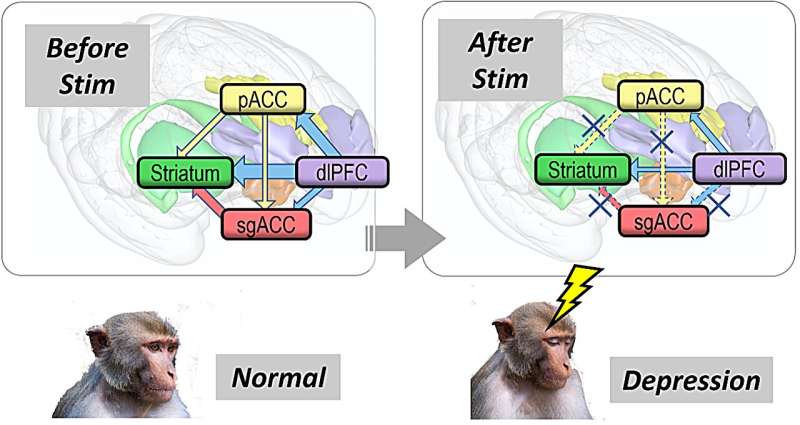This article has been reviewed according to Science X's editorial process and policies. Editors have highlighted the following attributes while ensuring the content's credibility:
fact-checked
peer-reviewed publication
trusted source
proofread
Researchers discover top-down signals in brain circuits regulating depression

Understanding and treating depression, a potentially debilitating mental health condition that affects millions of people worldwide, remains a major priority among researchers in the field of neuroscience. For example, major depressive disorder (MDD) affects around 33 million people and as much as 5% of the adult population globally.
Emotion regulation is a crucial function of the brain to suppress emotions and depression-like states and has been considered one of the defense mechanisms of MDD. However, the underlying neurobiological mechanisms of how the brain regulates the depression-like state are still unclear.
To explore this problem, a recent study led by Satoko Amemori and Ken-ichi Amemori and published in Nature Communications investigated how specific brain circuits regulate emotional responses, providing new insights into the neural basis of depression.
In this study, the researchers focused on the dorsolateral prefrontal cortex (dlPFC), which has long been known to play a role in regulating emotions. The researchers examined how the signal of the dlPFC changes in the depression-like state, and revealed the mechanism of how the dlPFC regulates the cingulo-striatal network.
Elucidating the neural mechanisms behind depression-like behavior in primates could lay the groundwork for developing novel therapeutic approaches that target specific brain circuits.
The research examined the so-called "top-down" influence of the dlPFC on the cingulo-striatal network, a brain network commonly associated with depression, in emotional regulation. They further examined how these circuits affect decision-making and emotional responses.
By using microstimulation techniques, the researchers modulated the neuronal activity of the subgenual anterior cingulate cortex (sgACC) of rhesus macaques (Macaca mulatta) and were able to experimentally induce pessimistic decision-making and depression-like states.
During these stimulation experiments, the researchers further recorded local field potentials (LFPs) to analyze the top-down influence of the dlPFC on the cingulo-striatal network.
They found that the experimentally induced pessimistic decision-making was accompanied by a decrease in the top-down influence of the dlPFC on the cingulo-striatal regions.
This finding suggests disrupting the top-down signal from cognition to emotion might result in pessimistic decision-making—a hallmark of MDD.
One of the key findings of the study was the role of beta oscillations in the fronto-striatal circuits. Beta oscillations have long been associated with motor control and attention and, more recently, have also been found to play a role in cognitive functions such as working memory.
In this new study, the effective microstimulation of the sgACC, which led to a depression-like state, reduced the magnitude of beta oscillations encoding positive decision-related variables.
This reduction in beta oscillations is important because it suggests a link between activity in the sgACC and negative bias in decision-making, providing a potential mechanism for how the brain processes positive and negative values.
The study also explored the interactions between areas within the fronto-cingulo-striatal network. By examining factors such as coherence and Granger causality (a statistical test for determining whether a variable can be meaningfully described as a dependent variable), the researchers found that effective microstimulation of the sgACC altered these interactions, reflecting the network's involvement in the decision-making process.
They found that the "top-down" influence of the dlPFC on the cingulo-striatal network was encoded by the beta oscillation of the LFP, and the reduction of the top-down influence was associated with the experimentally induced depression-like state.
These results highlight the important role this network plays in emotion regulation and decision-making and how its dysfunction might lead to depression-like behavior.
This study provides valuable insights into the neural basis of depression, highlighting the role of specific brain circuits in regulating emotional responses. Of note, the study created a primate depression model and revealed that front-cingulo circuits are involved in the regulation of the limbic system via beta oscillations.
Importantly, the researchers were able to demonstrate that the monkeys exhibit depression-like behavior when this regulation is absent. By uncovering the mechanisms underlying depression-like behavior in primates, this research opens new avenues for developing more effective treatments for MDD.
More information: Satoko Amemori et al, Cingulate microstimulation induces negative decision-making via reduced top-down influence on primate fronto-cingulo-striatal network, Nature Communications (2024). DOI: 10.1038/s41467-024-48375-1



















